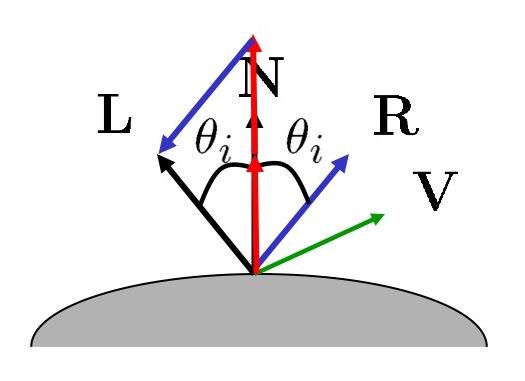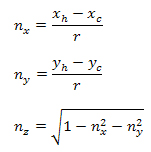| [Basic Algorithm] | [Extensions] | [Experimental Results] |
| [Appendix] User Interface | [Reference] | |
| Download: Test Data, Executable File, Source Code | ||
In this project, I implemented several algorithms to construct a depth field from a series of images of a diffuse object under different point light sources. My work is listed as follows (with * to indicate extensions):
| Normal estimation | Depth estimation |
| Use chrome ball | Solve a least squares fit |
| Example-based* [2] | Frankot-Chellappa algorithm* [5] |
| Not use chrome ball* [3] |
1. Basic Algorithm
The overall process of constructing photometric stereos basically consists of four steps:1.1 Light Source Direction Estimation: Using a chrome ball under different light source point, to construct the directions of these light sources since the normal at any given point on the ball is known.
(Related file: LightDirs.cpp.)

Fig. 1 Lighting direction estimation.
Second, for each image of the chrome ball, estimate the highlight center by taking the averages of coordinates of all the pixel in the highlight area (intensity > 0.9).
Finally, for each image of the chrome ball, compute the light source direction using the formula (illustrated in Fig. 1)
 (1)
(1) 
1.2 Surface Normal Estimation: After all the light source directions are determined, estimate the surface normal vectors of each point on the object.
(Related file: Normals.cpp.)
The appearance of the object is modeled as
 , where I is the pixel intensity, kd is the albedo, and L is the lighting direction (a unit vector), and n is the unit surface normal. Let
, where I is the pixel intensity, kd is the albedo, and L is the lighting direction (a unit vector), and n is the unit surface normal. Let  , g can be calculated by solving a linear squares problem:
, g can be calculated by solving a linear squares problem: (2)
(2)To avoid the effect of shadows, each pixel is weighted by its intensity, i.e. use a new objective function
 (3)
(3)1.3 Albedo Estimation: The albedo of the surface can be computed simultaneously with the surface normal or can be computed separately. My implementation calculates them separately for better accuracy.
(Related file: Albedos.cpp.)
The formula is
 (4)
(4)1.4 Depth Estimation: After the surface normals have been calculated, compute the depth of each image pixel.
(Related file: Depths.cpp.)
As the normal vectors are perpendicular to any vector on the surface, we have
 (5)
(5)in the x and y directions, respectively.
| [Back to Top] | [Go to Next] |
-----------------------------------------------------------------------------------------------------
Copyright (c) 2009 Wei Zhang